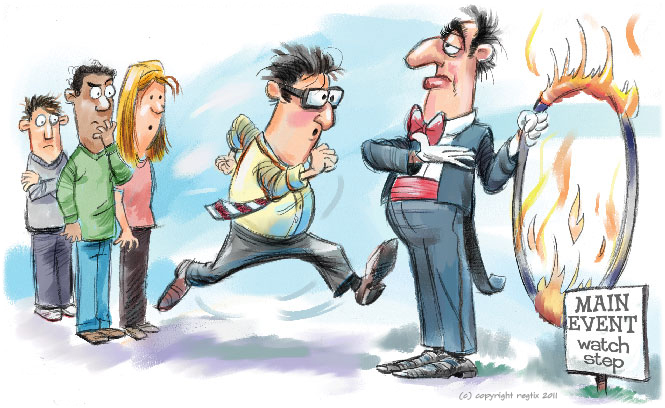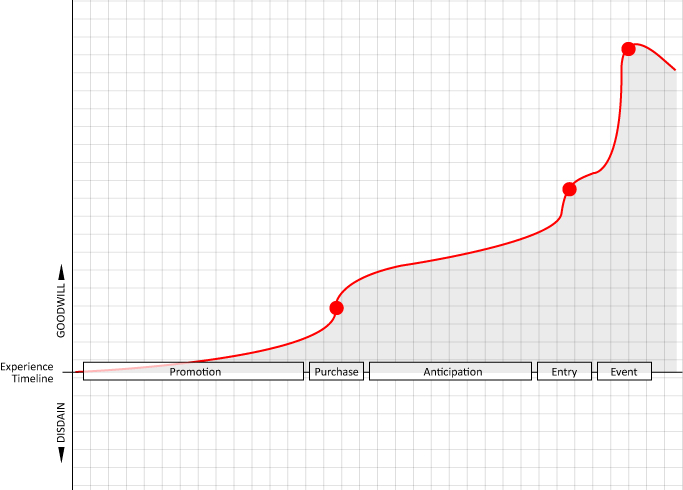Why Make it Difficult?
When you buy a product--no matter where you buy it--in the end, you get the same product. This is why in retail sales, marketers and sales experts focus on the experience of buying.
But events are different. Unlike most products and services that result in the same end, the experience of an event is unique and often special to each person attending. Events are about a talented person or group of people creating an experience. Event organizers, artists, educators, and performers focus all of their energy on that one thing: The Experience.
Almost all great events are successful because they create an experience that people desire so much, they will do whatever it takes to attend. They will pay more. They will travel. They will wait in long lines. They will jump through almost any hoop you ask them to in order to attend. This type of allure is what every event organizer works for to attract crowds of paying customers; however, this power is a double-edged sword.
As an event organizer, it's easy to start neglecting the peripheral experiences that support and lead up to the climax of your event. At Regtix, we focus on these supporting experiences:
1) Promotion
2) Purchase
3) Anticipation
4) Entry
Neglecting these important experiences leads to negative feelings about your event. Common complaints include:
- Exorbitant fees on tickets
- Slow systems and excessive wait times when buying tickets
- Difficulty finding desired seats
- Difficulty finding answers to questions about events
- Long lines and confusion when entering events
Now, you might be asking yourself, "If people are willing to pay and do anything to attend my event, why should I care if they are happy about the secondary experiences?"
The answer is simple. You can maximize the success of your event (aka how much money you make) by looking at the experience your patrons have as whole:
The first thing you should notice is that the actual "Event" makes up only a small portion of the overall experience. Granted, it's by far the most important part. But it's not everything.
As patrons of your event move through the Experience Timeline from promotion to experience the actual event, their emotions are constantly shifting. There's a lot of psychology involved.
During promotion, your patrons start to get excited. They want to attend, and they begin to crave the experience they know you will offer. At the height of their excitement, they come to a pivotal moment: Purchasing Tickets. Once your patrons have their tickets in hand, the real anticipation starts to build. For many events, the anticipation is nearly as exciting as the event itself. Anticipation is a very powerful force. Finally, you get to another crucial moment in the event experience: Entry. This is the last experience your patrons will have before they experience what they came to enjoy.
For some event organizers, it's easy to focus most of the effort on the event itself. They believe that if the event is a smash hit, that's enough. And in some ways, that's true. Here's an example of an Experience Timeline where an event organizer allows the event to ride solely on the power of the experience:
You can see the critical moments:
1) Purchase
2) Entry
3) The Event Itself
You can also see how goodwill (people having positive emotions about your event) climbs on its own as the timeline moves forward.
On this timeline, patrons had a bad experience 1) at the time of purchase and 2) at the time of entry. What happened? Well, first of all, the online ticket website was slow and it was hard to find the right seats. The fees were outrageous and people were left feeling burned. Then when it came time to enter the event, the lines were long and checking in was a big hassle.
As you can see, the event ended on a high note. The power of the event itself was enough to make up the ground lost by negative emotions at the time of purchase and during entry.
So what's the problem? This event is missing out big time. Let's take a look at an event where the organizers focus on the entire experience timeline:
Instead of a bad experience, patrons of this event loved how easy it was to find the right tickets and buy them. They didn't mind low service fees and anticipation was fueled by a good buying experience. Smart, fast entry systems were used to get patrons in the door fast, so the climax of their anticipation wasn't extinguished by long lines and confusion at the time of entry. These event-goers were primed to reach the ultimate climax of the event experience.
This pattern is an improvement, but it could be improved upon even more with greater focus on promotion and anticipation. When event organizers focus on the entire experience timeline, there are no limits as to how much goodwill they can create in the patrons who attend their events.
And goodwill is important. As your patrons experience higher levels of goodwill, they are:
- More likely to share their excitement with friends and family
- More likely to feel good about their decision to purchase
- More likely to post nice things about your event on Facebook and Twitter
- More likely to pay higher prices for your event
- Primed to have the best possible experience at your event
- More likely to attend your event more often
The opposite is also true. When your patrons' emotions dip down into the DISDAIN area, they are:
- More likely to complain about your event
- Less likely to buy tickets or more likely to regret their decision to buy tickets
- More likely to skip the event all together
- More difficult to impress, instruct, and enlighten at the time of your event
Hopefully it's clear how important it is to look at the big picture when it comes to organizing your event. In the coming weeks we'll be delving deeper into each of the supporting experiences: Promotion, Purchase, Anticipation, and Entry.
Our goal is to show event organizers that it doesn't require much extra time, effort, or money to transform your event from one that makes your patrons jump through hoops into an event that makes your patrons jump for joy--every step of the way.


